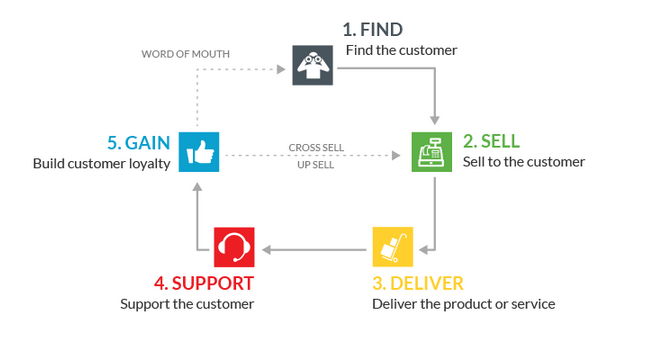As with a lot of other entrepreneurs, one of the biggest challenges we had to face was figuring out a way to cultivate a loyal fan base. The whole concept of growth hacking used to make my eyes glaze over with thoughts of turning my little startup into a giant juggernaut.
I was Charlie, and growth hacking was my Golden Ticket to the Chocolate Factory.
Of course, things didn’t play out exactly as I thought they would. Growth hacking was no silver bullet, and it turns out that the “Factory” part had more weight than the “Chocolate” part.
The past three years at WORK[etc] since then weren’t wasted, though. Through a lot of trial and error, I realized that growth hacking was just the first part of the equation.
What I really needed to do was to spread the concept and hack the entire customer lifecycle.
What is the customer lifecycle?
The customer lifecycle can be broken down into the following stages:
1. Find the customer
2. Sell the customer on your product or service
3. Deliver your product or service to the customer
4. Provide customer support for your product or service
5. Build customer loyalty from positive experiences
6. Repeat ad infinitum
Stage 1: Find the customer
This is where growth hacking takes center stage. With all the strategies, best practices, and tips floating around about how to growth hack effectively, we’ll leave Stage 1 to the experts.
Stage 2: Selling to the customer
Times have changed, and so should your marketing mantras. Instead of ABC, or “Always be closing”, start thinking ABS: “Always be selling.”
Think of every piece of communication with your customer as a chance for you to market your product or service. When it’s time to send out quotes, for example, don’t just stick to line items outlining costs. A customer who can clearly see tangible results (increased site visits, time and effort saved, etc.) is more likely to continue doing business with you even if he or she is staring at a $1,000 quote.
This strategy can also be extended to invoices sent out to paying customers. You can include links to tutorial videos, webinars, or any other free extras that can help customers use your product more efficiently. A sneak peek at new features or services you have lined up can also help generate more buzz.
Stage 3: Delivering to the customer
As I mentioned, the cycle doesn’t end once you’ve convinced a client to pay for what you’re selling. Once you’ve closed a sale, it’s time to nurture that initial trust you’ve built with a few good surprises.
One way we do this is by offering services not explicitly mentioned in our demos and on the site. Switching CRMs can take time, effort, and a level of expertise that not everyone has. To make the transition easier, we call up our new customers and offer to export data from their old systems to WORK[etc] for free.
We don’t necessarily advertise this service; it’s just a little extra we throw in for those who believe enough in our product to pay good money for it.
Stage 4: Providing customer support
If your support team answers around 50 support tickets every day, chances are five or so of those will be pretty detailed and informative solutions.
Now, as they are, those detailed support answers will already help your agents resolve future inquiries about the same problem more quickly. The customer is happy; the support agent gets a pat on the back for excellent work. End of story? Not necessarily.
Take a few minutes to edit those answers, take out confidential information, and post them as unique content on your website and you can not only reach a wider audience, you can also generate more site visits.
This content recycling process is easy enough to do that you can turn it into a daily task. If you put up five new pieces of unique content every day, by the end of the year you’ll end up with a few thousand pages of almost free content. If each page is only generating a few search engine hits each month, then that is still a significant boost in traffic.
Stage 5: Build customer loyalty
Truth be told, WORK[etc] doesn’t have a big marketing arm. In fact, it’s basically just me and one other guy. Our budget reflects our size: small. Still, we’ve managed to grow from one to over a thousand customers in the past few years.
A lot of that growth can be traced to our super fans — users and advocates who truly believe in both WORK[etc] the product and WORK[etc] the company. These tireless advocates help us by providing valuable feedback and sometimes even helping out their fellow users with issues and questions.
For a time, we didn’t really have a process for taking care of and best utilizing our advocates. Now we use an advocate marketing platform from Influitive called AdvocateHub to provide them with challenges and rewards for their continued support. We’re also starting to use it to let our biggest product champions try out some new features before anyone else.
Completing the circle
Don’t make the mistake of thinking you are going to be that one-in-a-million startup and focus all your efforts on hacking the first stage of the customer lifecycle. Finding an audience and signing customers is an important part of growth, but by focusing on the entire customer lifecycle there are other low-effort hacks to turn what you are already doing into growth.





